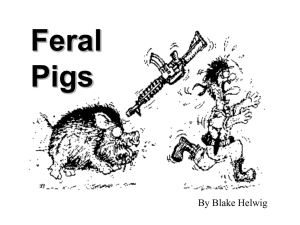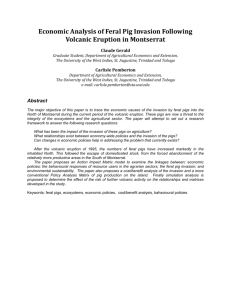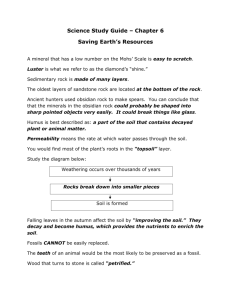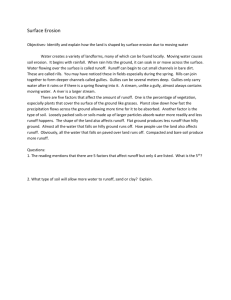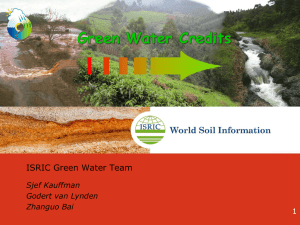Spatial And Temporal Dynamics And Effects of Feral Pigs On
advertisement
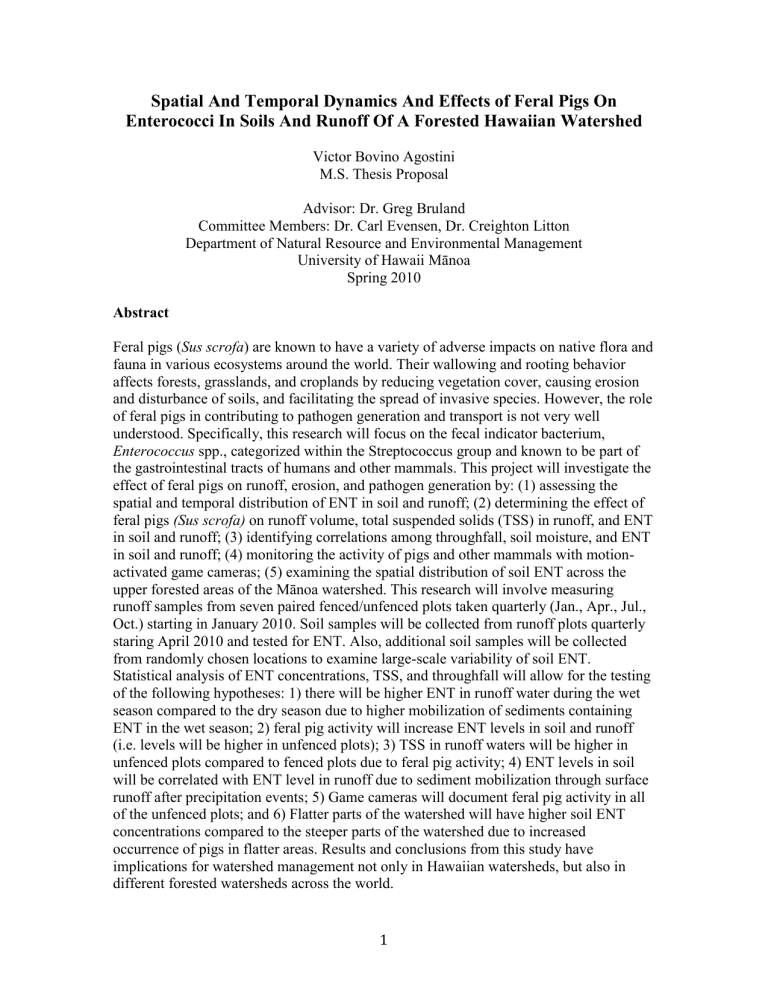
Spatial And Temporal Dynamics And Effects of Feral Pigs On Enterococci In Soils And Runoff Of A Forested Hawaiian Watershed Victor Bovino Agostini M.S. Thesis Proposal Advisor: Dr. Greg Bruland Committee Members: Dr. Carl Evensen, Dr. Creighton Litton Department of Natural Resource and Environmental Management University of Hawaii Mānoa Spring 2010 Abstract Feral pigs (Sus scrofa) are known to have a variety of adverse impacts on native flora and fauna in various ecosystems around the world. Their wallowing and rooting behavior affects forests, grasslands, and croplands by reducing vegetation cover, causing erosion and disturbance of soils, and facilitating the spread of invasive species. However, the role of feral pigs in contributing to pathogen generation and transport is not very well understood. Specifically, this research will focus on the fecal indicator bacterium, Enterococcus spp., categorized within the Streptococcus group and known to be part of the gastrointestinal tracts of humans and other mammals. This project will investigate the effect of feral pigs on runoff, erosion, and pathogen generation by: (1) assessing the spatial and temporal distribution of ENT in soil and runoff; (2) determining the effect of feral pigs (Sus scrofa) on runoff volume, total suspended solids (TSS) in runoff, and ENT in soil and runoff; (3) identifying correlations among throughfall, soil moisture, and ENT in soil and runoff; (4) monitoring the activity of pigs and other mammals with motionactivated game cameras; (5) examining the spatial distribution of soil ENT across the upper forested areas of the Mānoa watershed. This research will involve measuring runoff samples from seven paired fenced/unfenced plots taken quarterly (Jan., Apr., Jul., Oct.) starting in January 2010. Soil samples will be collected from runoff plots quarterly staring April 2010 and tested for ENT. Also, additional soil samples will be collected from randomly chosen locations to examine large-scale variability of soil ENT. Statistical analysis of ENT concentrations, TSS, and throughfall will allow for the testing of the following hypotheses: 1) there will be higher ENT in runoff water during the wet season compared to the dry season due to higher mobilization of sediments containing ENT in the wet season; 2) feral pig activity will increase ENT levels in soil and runoff (i.e. levels will be higher in unfenced plots); 3) TSS in runoff waters will be higher in unfenced plots compared to fenced plots due to feral pig activity; 4) ENT levels in soil will be correlated with ENT level in runoff due to sediment mobilization through surface runoff after precipitation events; 5) Game cameras will document feral pig activity in all of the unfenced plots; and 6) Flatter parts of the watershed will have higher soil ENT concentrations compared to the steeper parts of the watershed due to increased occurrence of pigs in flatter areas. Results and conclusions from this study have implications for watershed management not only in Hawaiian watersheds, but also in different forested watersheds across the world. 1 Introduction / Literature Review About Sus scrofa Pigs were among the first mammals to be domesticated, beginning in China some 7,000 years ago and possibly dating further back to 10,000 B.C. (Nowack 1991). Several millennia of selective breeding yielded a domesticated animal that is morphologically distinct from the wild type from which they derived. The first introduction to the United States may have been an intentional introduction of domesticated hogs to the Hawaiian Islands by Polynesians perhaps 1,000 years ago (Nowack 1991). Presently, feral pigs (Sus scrofa) are found globally in a variety of ecosystems. They have been introduced in various locations where they did not occur naturally, and have consequently caused significant ecological and economical damage. The nearly global distribution domesticated and feral pigs have had direct and indirect physical, chemical, and biological impacts across different landscapes. For the State of Hawaii, feral pigs are found throughout the lower and upper reaches of watersheds and have negative effects on both native and human-modified ecosystems (Tomich 1986). Feral pigs have a high reproductive potential, adaptability to varying habitats, and the capability to expand their range and colonize rapidly (Tisdell 1982, Mayer and Brisbin 1991). These reasons are perhaps why the management of this species is so difficult in Hawaii and elsewhere. In temperate regions, breeding of Sus scrofa is confined to the spring, whereas in subtropical and tropical climates the breeding season occurs throughout the year (Ingles 1965). In both temperate and tropical climates, peek breeding coincides with the rainy season (Nowak 1991). Both sexes usually reach sexual maturity in the first year of life between 8-12 months in males and as early as 5-8 months in females (Johnson et al. 1982). Despite early onset of maturity, female feral pigs usually do not breed prior to reaching18 months of age; while males tend not to achieve reproductive success until they are fully grown at approximately age five (Ingles 1965). Litters usually consist of between 3-12 young and females generally produce one or two litters each season throughout their reproductive lives (Ingles 1965, Gingerich 1994). Environmental Impacts of Feral Pigs In the State of Hawaii, feral pig populations and associated ecological impacts have been documented for several decades (Katahira 1980, Doing 1982, Vtorov 1993, Anderson and Stone 1993). Some of the problems caused by feral pigs include their role in decreasing native vegetation cover, disturbing soil structure and causing erosion, and causing bacterial contamination in soil and stream waters (Dunkell 2009). This can potentially affect human health as well as the health of coastal ecosystem such as coral reefs. According to Peine and Farmer (2009) feral pigs are categorized as omnivorous and may eat fish, snakes, frogs, salamanders, mussels, snails, small mammals, carrion, earthworms, immature and adult insects, and the eggs of young and ground nesting birds. Additionally, vegetation is a major part of their diet (Peine and Farmer 1990). Much of 2 their diet comes from belowground plant biomass and from biota, which inhabit the soil and leaf litter. A study by Bueno et al. (2009) pointed out that among feral pigs’ behavior, rooting may have the most significant impact on soils, vegetation, and grounddwelling organisms in Hawaii’s watersheds. While rooting, feral pigs turn over the soil looking for different food types (such as bulbs, invertebrates, or even small mammals), which can have an impact that varies from a few square centimeters to hundreds of hectares (Welander, 2000; Massei & Genov, 2004). Rooting may lead to an alteration of plant cover and a significant loss of soil due to transportation of soil particles through runoff water (Bueno et al. 2009). Natural habitats are susceptible to damage from feral pig populations. A study done in the Great Smokey Mountains National Park reported that the destructive behavior of feral pigs cause to the exposure of several thousand tree roots per hectare, reduced plant cover by as much as 80%, and increased bare ground by nearly 90% (Singer et al. 1984). Forest litter was also greatly reduced while erosion and nutrient loss from the forest floor to receiving river waters was doubled. This study also discussed water-quality effects of wild pig rooting and wallowing such as sedimentation, increased fecal contamination, nutrient mobilization, and impacts to aquatic biota. Nitrate concentrations were higher in soil and stream water from the rooted areas suggesting alterations in nitrogen transformation processes (Singer et al. 1984). Widespread feral pig disturbance of forest ecosystems results in removal of vegetation and leaf litter, exposing and loosening soils that may become more susceptible to mobilization by surface waters and erosion. This may contribute to turbidity of surface water bodies and potential downstream sedimentation, especially during flood periods following extensive rooting. In addition to loss of native vegetation and soil erosion, feral pig activity also causes spread of opportunistic weeds into newly disturbed areas (Kotanen 1995, Cushman et al. 2004). It is believed that pigs have facilitated dispersal of invasive plant species throughout the Californian coastal prairies by exposing soils and through their fecal waste (Kotanen 1995, Cushman et al. 2004). It is clear that feral pigs not only can harm native vegetation and fauna population but they also impact the health and function of entire watersheds (Cushman et al. 2004). In Hawaii, feral pigs damage and even kill several native plants species by felling or barking them in pursuit of native tree ferns that are a dietary staple (Diong 1982). In addition to disturbing soils, pigs also promote bacterial contamination in soil and in runoff waters. Intensive rooting and wallowing near surface water leads to greater turbidity and fecal contamination in and around stream water (Singer 1981). They also represent a potential source of other diseases like pseudo rabies, trichinosis, swine brucellosis, and leptospirosis, which can be fatal to humans (Gingerich 1994). Enterococcus spp. Enterococci, E. coli, and total coli forms are commonly used as fecal indicator bacteria (FIB) in soil, streams waters, and in the ocean. The presence of FIB in soil and surface waters is an important concern for communities that use water for recreational 3 purposes and/or human consumption. Most natural areas such as watersheds may contribute to the existence of these FIB in soil through the presence of mammals, which can contribute to streams contamination via surface runoff. Grant et al. (2001) found that ENT bacteria generated by mammals in a restored wetland had greater effect on coastal water quality. Additionally, Ahn et al. (2005) also recognized that natural sources of ENT could be significant contributors to total bacteria levels in urban storm water in southern California. These bacteria indicate the presence of fecal matter and therefore the potential presence of pathogens like Enterococci and E. coli that can infect the human body and cause health problems like gastrointestinal ailments, vomiting, blood infections, or deep tissue infections (Ahn et al. 2005). The use of these contaminated water bodies result in potential exposure to pathogens that can enter into the body through small cuts or through skin dermal sorption causing immune suppression (Henrickson et al. 2001). Another source of ENT bacteria is originated by feral pigs’ fecal material. This bacterium lives in feral pig gastrointestinal tracts and can cause life-threatening infections in humans. The two main measures to report ENT bacteria concentration in water are Most Probable Number (MPN) and Colony Forming Units (CFU). The procedures and experimental protocol for MPN and CFU have minor variation when compared to each other. The acceptable level of ENT in fresh water of 5 samples collected during a 30 days period is a geometric mean concentration of 33 MPN/100 mL in fresh water and 35 MPN/100 mL in marine waters (USEPA 1986). For a single sample collection, the MPN/100 mL cannot exceed 104 MPN/100 mL (USEPA 1986). ENT bacteria can be found in soil and in stream waters. The generation and transport of ENT is one of the major concerns regarding feral pigs in Mānoa watershed (Bruland et al. 2010). Preliminary research indicates that these animals disperse ENT into the soil, which can then be transported through runoff waters into streams (Dunkell 2009). Soil erosion and sediment transportation have a strong link with the contamination levels at the watershed scale. More recently, new quantitative information concerning the influence of feral pigs on water quality and aquatic biota has begun to emerge in the literature. Feral pigs have been associated with increased fecal coliform levels, increased biological oxygen demand (BOD), presence of pathogenic bacteria, and changes in aquatic microbial and invertebrate communities in forested floodplain streams (Kaller et al. 2007). A recent study further described potential negative influences of pig rooting in forested wetlands and aquatic habitats in northern Florida (Means and Travis 2007). This study found that feral pigs increased erosion, turbidity, and sedimentation from rooting activities, resulting in direct and indirect effects on aquatic biota and other communities. According to Dunkell (2009) elevated ENT levels in runoff did not significantly correlate with other environmental variables such as amount of TSS in runoff, soil moisture, or ground cover. 4 Objectives and Hypotheses The overall goal of this study is to investigate the spatial and temporal variability and effects of feral pig (Sus scrofa) exclusion on ENT in soil and runoff of a Hawaiian watershed. The specific objectives are to: 1) Investigate the spatial and temporal distribution on ENT in soil and runoff across Mānoa watershed; 2) Quantify the impact of feral pigs (Sus scrofa) on runoff volume, total suspended solids (TSS) in runoff, and ENT in soil and runoff from fenced and unfenced plots in seven different locations in the Mānoa Watershed; 3) Identify the correlations among throughfall, soil moisture, and ENT in soil and runoff water; 4) Monitor the activity of pigs and other mammals with motion-activated game cameras; 5) Investigate the spatial distribution of soil ENT from additional multiple sites across the upper forested Mānoa watershed. Based on the objectives listed above, this research will test the following six hypotheses: 1) There will be higher ENT in runoff water during the wet season compared to the dry season due to higher mobilization of sediments containing ENT in the wet season; 2) Feral pig activity will increase ENT levels in soil and runoff (i.e. levels will be higher in unfenced plots); 3) Total suspended solids (TSS) in runoff waters will be higher in unfenced plots compared to fenced plots due to feral pig activity; 4) ENT levels in soil will be correlated with ENT level in runoff due to sediment mobilization through surface runoff after precipitation events; 5) Game cameras will document feral pig activity in all of the unfenced plots; 6) Flatter parts of the watershed will have higher soil ENT concentration in compared to the steeper areas due to increased occurrence of pigs in flatter areas. Methodology Study Sites Mānoa watershed is located on the Island of O‘ahu between Makiki and Pālolo Valleys. These three valleys comprise the larger Ala Wai Watershed. The watershed 5 covers an area of approximately 18 km2, from the Ko‘olau Mountains to the confluence of Mānoa and Pālolo streams. The Mānoa watershed can be divided in two parts, the upper section and lower section. The upper segment of the watershed contains steeper, well-forested slopes. This forest is largely dominated by non-native species. Several tributaries feed secondary streams, which eventually drain into Mānoa stream. The lower section contains gentle slopes also dominated by non-native species. Within the low level costal areas of the watershed there is an increasing human population growth. Seven paired fenced/unfenced plots were established at seven different sites throughout the Mānoa watershed in summer 2007. The seven sites include: Lyon Arboretum, Mānoa Falls, Pu’u Pia, Mānoa Cliffs, Pauoa Flats, Roundtop, and Wa’ahila Ridge. Of these seven sites, three are located approximate 100 m away from the streams (Lyon Arboretum, Mānoa Falls, and Pu’u Pia). Each site consists of two-paired 5 x 10 m plots, one enclosed by a fence to avoid pigs and other animal’s disturbance and one unfenced. The 0.91 m tall fences are made out of 14-gauge utility and fence an approximately 50 m2 area. A strand of with barbed wire was placed at the ground level to prevent pigs from digging under the fence. Soil and Runoff Water Sampling Within each individual 5 x 10 m plot, a 4.2 x 1.2 m runoff plot was installed to channelize all runoff into a buried container. Runoff plots are oriented to run from higher elevation to lower elevation, with slopes ranging from 5-27%. Plots are sheltered from outside overland flow by a 15 cm tall plastic wall buried approximately 7.5 cm deep. The plastic pieces form a watertight barrier surrounding the runoff plot. Each of the seven sites will be activated prior to a rain event. Activation consists of emptying throughfall gauges and cleaning runoff collector buckets. Soil samples will be taken for ENT bacteria and soil moisture analysis. Samples will be collected from the upper 5 cm of the soil profile, approximately 30 cm from each corner of the runoffchannelizing plot with disposable spoons. A total of eight samples will be collected at each site; however, the four samples taken within the same plot will be composited. Samples will be stored in sterile disposable Ziploc bags and transported on ice to the laboratory. ENT soil analysis will take place within 24 hours of collection. To estimate the total runoff amount, the water depth will be measured in the bucket with a ruler and the total volume of runoff water will be estimated using a regression formula. After measuring depth, runoff collected in the bucket will be thoroughly mixed, and water samples will be subsequently taken. One sample from each bucket will be taken in a sterile (single-use) container for ENT testing, and a second sample from each bucket will be taken in a clean, acid-washed bottle for use in determining total suspended solids (TSS). Runoff samples will be taken quarterly throughout the year (Jan., Apr., Jul., Oct.) starting in January 2010. All sampling will occur after significant rainfall events. A significant rainfall event will be determined to occur when the U.S. Geological Survey 6 (USGS) online real-time rain gauge at Kanewai Field records an event of 5 mm of rainfall or higher. (http://waterdata.usgs.gov/hi/nwis/uv/?site_no=211747157485601&PARAmeter_cd=000 45). Laboratory Analysis All runoff water samples will be tested for ENT bacteria and TSS. The ENT test will be performed using an IDEXX instrument (IDEXX Laboratories, Inc., Westbrook, Maine). This process is the only commercial microbiological test included in the American Water Works Association’s (AWWA) Standard Methods for Examination of Water and Wastewater, 20th Edition. TSS measurements will be completed by extracting 100 mL of mixed solution and pouring it onto an 11 cm diameter, Whatman 5 filter paper within a Buchner funnel attached to a vacuum flask (Browning 2008). As the solution is pulled through the filter, suspended particles 2.5 µm or greater will be captured. The filter will then be dried for 24 hours at 105oC. Afterwards, the filter will be weighed again and the original weight (prior to solution) will be subtracted to produce the TSS amount in g L-1 (EPA 1971). From the soil samples collected in each plot, soil moisture will be computed gravimetrically by weighing subsamples from the sample, drying them at 105oC for 24 hours, and re-weighing. Game Cameras Cuddleback Capture Infrared 3.0 megapixel game cameras will be installed at every site. The game cameras will help to quantify the amount of feral pigs and other mammal activity (i.e. dogs, cats, mangoose) among sites throughout the project. The cameras will be set with a 30 second delay between photographs to avoid obtaining multiple images of the same feral pig(s). Previous studies have found that game cameras are efficient and cost-effective for the rapid assessment of ungulate abundance in remote areas (Rovero and Marshall, 2009). Statistical Analysis Collected data will be managed with the use of Microsoft Excel spreadsheets. Analysis of the data will be performed using statistical analysis methods, including repeated measures analysis of variance (ANOVA), correlation, and regression analysis. The paired runoff plots will allow for repeated measures ANOVA, analyzing the values for each plot over the entire study period. Correlation analyses will be used to identify the relationships among ENT and other environmental variables. Additionally, regression analysis will also be implemented to determine the best predictors of ENT in runoff and soil. 7 Expected Results It is expected that unfenced plots will show pig disturbance producing higher level of total suspended solids in runoff, and higher levels of ENT in soil and runoff. Due to the wallowing and rooting behavior of feral pigs, soil structure will highly affected in the unfenced plots and runoff water from the unfenced plots will show higher levels of total suspended soil (TSS) in samples collected after rain events. Soil disturbance and feral pigs activity will cause increased fecal contamination, increasing ENT levels in soil and runoff samples. It is anticipated that unfenced plots will reveal higher ENT levels in both the soil and runoff water. All these expected results are linked to precipitation events. High rainfall amounts will increase the quantity of runoff that will transport suspended sediments throughout the streams, increasing water turbidity and bacterial distribution. Enterococci bacterium is transported from the soil surface into the streams through precipitation runoff. It is speculated that precipitation events will be higher during fall and winter periods, creating higher levels of runoff during these times. Overall, this study will help to demonstrate that ENT levels are correlated with throughfall and runoff. With less runoff it will be possible to see a smaller impact of pig fecal contamination. If these results occur as expected, certain actions can be taken to limit the access of feral pigs in the upper section of the watershed where precipitation tends to be higher. Proposed Thesis Outline Chapter 1- Introduction, Literature Review, Objectives and Hypothesis Chapter 2- Spatial and Temporal Variability of Throughfall, Moisture, TSS, and ENT in Soil, Runoff and Stream water Chapter 3- Conclusions 8 References Ahn, J.H., Surbeck, S.B., DiGiacomo, C.Q., Nezlin, P.M., & Jiang, S. (2005). “Coastal water quality impact of storm water runoff from an urban watershed in southern California”. Environmental Science and Technology, 39(16):5940–5953. Anderson, S.J. & Stone, C.P. (1993). “Snaring to control feral pigs (Sus scrofa) in a remote Hawaiian rain forest”. Biological Conservation. 63:195:202. Brower, K. (1985). “The Pig War”. The Atlantic Monthly 256(2):44-58. Browning, C.A. (2008). “A Preliminary Examination of the Effects of Feral Pigs (Sus scrofa) on Water Quality and Soil Loss Within a Hawaiian Watershed”. Master Thesis, Department of Natural Resources And Environmental Management, University of Hawaii at Mānoa, Honolulu, Hawaii. Bruland, G.L., C.A. Browning, C.A., & Evensen, C.I. (2010). “Effects of Feral Pigs (Sus scrofa) on Watershed Health in Hawaii: A Literature Review and Preliminary Results on Runoff and Erosion”. In J. Roumasset, K. Burnett, and A. Balisacan (eds.), Sustainability Science for Watershed Landscapes. Singapore: Institute of Southeast Asian Studies; Los Banos, Philippines: SEARCA, ISEAS Publishing, Singapore, pp. 251-277. Bueno, C.G., Alados, C.L., Gomez-Garcıa, D.G., Barrio, I. C. (2009). “Understanding the main factors in the extent and distribution of wild boar rooting on alpine grasslands”. Journal of Zoology 279(2):195-202. Cushman, J. H., T. A. Tierney, and J. M. Hinds. (2004). “Variable effects of feral pig disturbances on native and exotic plants in a California grassland”. Ecological Applications 14:1746–1756. Diong, C.H. (1982). “Population biology and management of the feral pig (Sus scrofa L.) In Kipahulu Valley, Mauil”. Ph.D. dissertation, Botany Department, University of Hawaii Mānoa, Honolulu, HI. Dunkell, D.O. (2009). “Runoff, Erosion, Fecal Indicator Bacteria, And Effects Of Feral Pig (Sus scrofa) Exclusion In Mānoa Watershed”. Master Thesis, Department of Natural Resources and Environmental Management, University of Hawaii at Mānoa, Honolulu, Hawaii. EPA. (1971). "EPA Method 160.2 " EPA Test Methods Retrieved November 8, 2008, From http://www.umass.edu/tei/mwwp/acrobat/epa160_2nonfiltres.pdf. Fenner, F.J., E.P.J. Gibbs, F.A. Murphy, R. Rott, M.J. Studdert, and D.O. White (eds.) (1993). Veterinary Virology (2nd Ed.). Academic Press, Inc. 9 Gingerich, J.L. (1994). “Florida's Fabulous Mammals”. World Publications. Tampa Bay. Green D.F., and Ortiz, F. (1982). “Status of sea turtle populations in the central eastern Pacific”. 128 p. Grant, S. B., Sanders, B. F., Boehm, A. B., Redman, J. A., Kim, J. H., Mrse, R. D., et al. (2001). “Generation of Enterococci bacteria in a coastal saltwater marsh and its impact on surf zone water quality”. Environmental Science and Technology, 35(12):2407–2416. Hawaii State Department of Health. Retrieved 2007-02-08 Henrickson, S. E., Wong, T., Allen, P., Ford, T. (2001). “Marine swimming related illness: Implications for monitoring and environmental policy”. Environmental Health Perspectives 109:645-651. Hampton, J.O., Spencer P.B.S., Alpers D.L., Twigg L.E, Woolnough A.P., Doust J., Higgs T. and J. Pluske. (2004). “Molecular techniques, wildlife management and the importance of genetic population structure and dispersal: a case study with feral pigs” Journal of Applied Ecology 41:735-743. Ingles, L.G. (1965). “Mammals of the Pacific States”. Stanford University Press. Stanford, California. Johnson, K.G., Duncan, R.W., and Pelton, M.R. (1982). “Reproductive Biology Of European Wild Hogs In The Great Smokey Mountains National Park”. Proceedings Of The Annual Conference Of The Southeastern Fish And Wildlife Agencies 36:552564. Kaller, M.D. and Kelso, W.E. (2006). “Swine activity alters invertebrate and microbial communities in a coastal plain watershed”. American Midlands Naturalist 156:163177. Katahira, L. (1980). “The effects of feral pigs on a montane rain forest in Hawaii Volcanoes National Park”. Proceedings: 3rd Conference in Natural Sciences, Hawaii Volcanoes National Park. Cooperative National Park Resources Studies Unit, University of Hawaii at Manoa, Honolulu, Hawaii. 173-178 p. Kotanen, P.M. (1995). “Responses of vegetation to a changing regime of disturbance: effects of feral pigs in a Californian coastal prairie”. Ecography 18:190-199. Massei, G. & Genov, P. (2004). “The environmental impact of wild boar”. Galemys 16:135–145. Mayer, J. J., and Brisbin, I. L. (1991). “Wild pigs in the United States: their history, comparative morphology, and current status”. University of Georgia Press, Athens, 10 USA Means, D.B. and Travis, J. (2007). “Declines in ravine- inhabiting dusky salamanders of the southeastern US coastal plain”. Southeastern Naturalist 6(1):83-96. Nowak, R.M. (1991). “Walker's Mammals of the World”. The John Hopkins University Press. Baltimore. 1629 p. Peine, J. and Farmer, J. (1990). “Wild hog management program at Great Smoky Mountain National Park”. Vertebrate Pest Conference 14:221-227. Rovero, F. and Marshall, A. R. (2009). “Camera trapping photographic rate as an index of density in forest ungulates”. Journal of Applied Ecology. 46:1011–1017. Singer, F.J. (1981). “Wild pig populations in the National Parks”. Environmental Management 5(3):263-270. Singer, F.J., Swank, W.T., and Clebsch, E.E.C. (1984). “Effects Of Wild Pig Rooting In A Deciduous Forest”. Journal Of Wildlife Management 48:464-473. Tisdell, C.A. (1982). “Wild pigs: environmental pest or economic resource?” Pergamon Press. Sydney, Australia. 445 p. Tolleson, D., Pinchak W., Rollins D., and Hunt, L. (1995). “Feral hogs in the rollings plains of Texas: Perspectives, problems, and potential”. Great Plains Wildlife Damage Control Conference 12:124-128. Tomich, P. Q. (1986). “Mammals in Hawaii: A Synopsis and National Bibliography.” Honolulu, Hawaii, Bishop Museum Press. U.S. Environmental Protection Agency, Ambient Water Quality Criteria for Bacteria (1986) EPA440/5-84002. Office of Water, Regulations and Standards, Criteria and Standards Division, Washington, DC, 20460. Vtorov, I.P. (1993). “Feral pig removal: effects on soil microarthropods in a Hawaiian rain forest”. Journal of Wildlife Management 57(4):875-880. Welander, J. (2000). “Spatial and temporal dynamics of wild boar (Sus scrofa) rooting in a mosaic landscape”. Journal of Zoology. (Lond.) 252:263–271. Whitaker, J.O. (1988). “The Audubon Society Field Guide to North American Mammals”. Alfred A. Knopf, Inc. New York. 745 p. 11
